Last Updated on July 28, 2024 by Kittredge Cherry
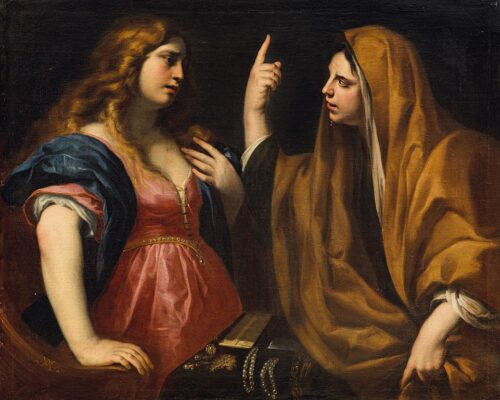
Mary and Martha of Bethany were two of Jesus’ closest friends. The Bible calls them “sisters” who lived together, but reading the Bible with queer eyes raises another possibility. Maybe Mary and Martha were a lesbian couple. Their feast day is July 29.
Mary and Martha formed a nontraditional family with their “brother” Lazarus at a time when there was huge pressure for heterosexual marriage. Martha was apparently head of the household because her name is listed first when the Bible mentions the threesome (John 11:5) and describes their home as “her house” (Luke 10:38).
The Feast of Mary and Martha is also significant as the date for the “irregular” ordination of the Philadelphia Eleven, including lesbian theologian Carter Heyward, on July 29, 1974. They defied the male hierarchy to become the first women ordained as Episcopal priests, two years before the Episcopal church officially allowed women’s ordination.
As Nancy Wilson, moderator of Metropolitan Community Churches, wrote in the brochure “Our Story Too: Reading the Bible with ‘New’ Eyes”:
“Jesus loved Lazarus, Mary and Martha. What drew Jesus to this very non-traditional family group of a bachelor brother living with two spinster sisters? Two barren women and a eunuch are Jesus’ adult family of choice. Are we to assume they were all celibate heterosexuals? What if Mary and Martha were not sisters but called each other ‘sister’ as did most lesbian couples throughout recorded history?”

Wilson expands on this theory in her book “Outing the Bible: Queer Folks, God, Jesus, and the Christian Scriptures.”
This potentially queer triad of two “sisters” and their “brother” is portrayed in a 16th-century painting of Martha Mary and Lazarus by the Spanish artist known as the Master of Perea. Some believe that Mary and Martha’s brother Lazarus was the Beloved Disciple of Jesus — and maybe even his same-sex lover.
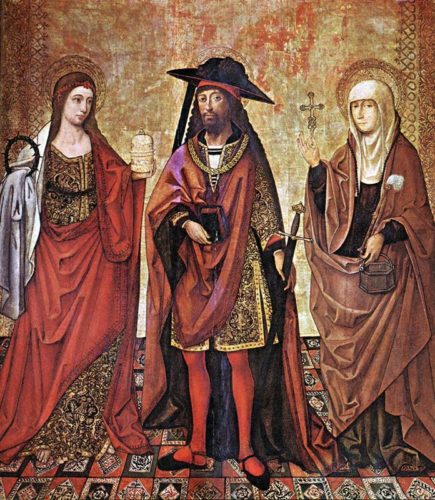
Lazarus between sisters Martha and Mary by the Master of Perea (Wikipedia)
Biblical patriarchs have also hidden their marriages by claiming their wives were their sisters. In the book of Genesis, Abraham claimed his wife Sarah was his sister on two different occasions (Genesis 12:10-20; 20:1-18) and once Isaac passed off his wife Rebekah as his sister (Genesis 26:1-16). Male lovers may also have claimed to be “brothers.”
Mary and Martha are best known for the conflict they had when they hosted Jesus and his disciples. Mary sat at Jesus’ feet to listen, but Martha wanted her to help her serve. Jesus’ famous answer: “Martha, Martha, you are worried and upset about many things, but only one thing is needed. Mary has chosen what is better, and it will not be taken away from her.” (Luke 10:41-42).
In another major Bible story, Jesus talks with Mary and Martha in turn before raising their brother Lazarus from the dead. During the conversation, Martha speaks what is considered the first profession of faith in Jesus: “I believe that you are the Christ, the Son of God, who was to come into the world” (John 11:27). Recent scholarship affirms that sister Martha and Mary of Bethany exist in Luke 10, but that the references to Mary and Martha in the resurrection story of John 10-11 are all actually about one woman, Mary Magdalene.
Like with most Biblical figures, the truth about Mary and Martha is a mystery. The gospels references are brief and sometimes contradictory. As a result, Mary of Bethany is identified as Mary Magdalene in the Roman Catholic church, while in Protestant and Eastern Orthodox traditions they are considered separate persons.
The Orthodox Church also includes Mary and Martha among the “myrrh bearing women” who were faithfully present at his crucifixion and brought myrrh to his tomb, where they became the first to witness his resurrection. Christian feminists also honor the couple and say that they probably were leaders of a “house church.”
According to legend, Mary, Martha and Lazarus continued in ministry together for decades in foreign lands. Orthodox tradition says that they fled persecution in Judea and moved to Cyprus, where Lazarus became the first bishop of Kition (modern Larnaca). In Roman Catholic tradition, they spread the gospel in Provence, France, where Lazarus become the first bishop of Marseille.
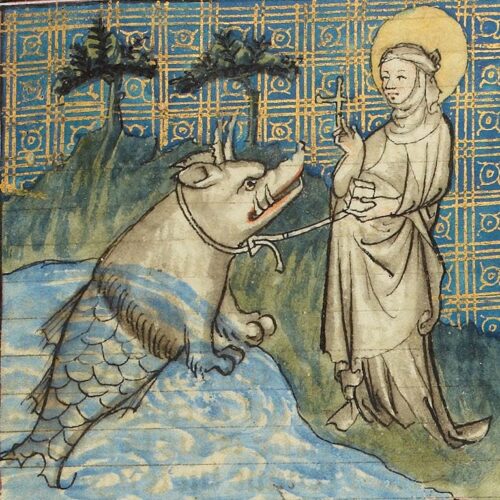
“Saint Martha and the Tarasque” by Jacques de Voragin (Wikipedia)
Hagiographies dating back to the 12th century describe how Martha blessed and tamed a murderous fire-breathing dragon known as “the Tarasque” that had been terrorizing the Provence region. Martha led the newly gentle monster into town, where different legends say it either died of shame for its past crimes or was killed by frightened villagers over Martha’s objections. The tale of the Tarasque has been influential since the 12th century and is a long-time favorite theme in artwork and festivals.
Artists provide some beautiful paintings of the “sisters,” including the one above by Italian Renaissance artist Bernardino Luini (1480 -1532).
Why does it matter?
This article sparked a long, lively debate at the Episcopalians on Facebook group with comments such as:
“Of course, no-one can know for sure, and it is always speculative to read back into the past ideas that have more recently developed. But the point of the exercise, I think, is to allow the question. What if? And to see how that opens up ways for LGBTQ people to see themselves as part of the people of God, and for our straight friends, allies and (alas) antagonists to see us.”
“It is important to keep an open mind to exegesis that seeks to revisit commonly-held ideas about our past. One of the main ways straight supremacy works is to marginalize and make invisible queer history and to impose a standard straight veneer on historical characters.”
___
Related links:
“Mary the Tower: What would Christianity be like if Mary Magdalene hadn’t been hidden from view?” by Diana Butler Bass
___
Top image credit:
Mary and Martha by Andrea Vaccaro, 1670 (Wikimedia Commons)
_________
This post is part of the LGBTQ Saints series by Kittredge Cherry. Traditional and alternative saints, people in the Bible, LGBTQ martyrs, authors, theologians, religious leaders, artists, deities and other figures of special interest to lesbian, gay, bisexual and transgender and queer (LGBTQ) people and our allies are covered.
This article was originally published on Q Spirit in July 2017, was expanded with new material over time, and most recently updated on July 28, 2024.
Copyright © Kittredge Cherry. All rights reserved.
Qspirit.net presents the Jesus in Love Blog on LGBTQ spirituality.
__________
















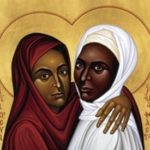
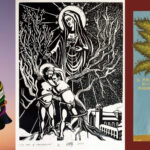



May I comment?
You may comment, but you must follow the comment policy as outlined on Q Spirit’s privacy page. I approved one of your recent comments, but not the other because it was a personal attack, did not stay on topic and created a hostile atmosphere. Here is the comment policy:
Q Spirit encourages open, respectful discussion through comments. A safe, polite environment is maintained by moderating comments based on the following principles:
1. No personal attacks.
2. No attacks on groups (including claims that homosexuality is a sin), no profanity, no calls for violence.
3. No repetitive comments.
4. No spam.
5. No profanity.
6. Comments must be on topic and in English.
7. Q Spirit reserves the right not to approve any comments for any reason, including those are offensive or that create a hostile atmosphere.
Like with most Biblical figures, the truth about Mary and Martha is a mystery. The gospels references are brief and sometimes contradictory.
So by the same logic, every group described as siblings “might” be a secret group of lesbian lovers and gay eunuchs living together? This is especially bad logic in the context of 1st century societies when it was common for entire extended families to live together, and certainly common for siblings. That doesn’t make them a “queer non-traditional family” because it was traditional in that society even if it’s more unusual today.
Just as unlikely for adult women to be unmarried and living with their brother and not with individual husbands after age 13 or so of you’re going to go for a literal, socio-cultural, geo political, historical contextual reading. Contemporary queer and trans linguistics and contexts aren’t used in Biblical Hebrew and Ancient Greek, but I’m willing to posit that people lived in ways that align with the way I live. The best I can do to see myself in the words written in these other languages and times, is to ask, might it be possible to read this relationship as something coded?
Esta públicacion sobre Marta y María me gustó pq me despeja las dudas si la homosexualidad es pecado.pq a pesar Q soy creyente en Dios y asisto a misa todos los domingo, siento q soy un pecador y no tendré la gloria de Dios ya q mis familiares dicen q la homosexualidad es pecado.y me siento mal
Thank you to Ivan, who wrote, “I liked this publication about Martha and Mary because it clears my doubts if homosexuality is a sin, because despite Q I am a believer in God and I attend mass every Sunday, I feel that I am a sinner and I will not have the glory of God since my Family members say that homosexuality is a sin and I feel bad.” Ivan, homosexuality is not a sin.
Scripture does not condemn loving, responsible homosexual relationships. There are many resources that fully explain the Bible and homosexuality. Here are a few that I recommend:
Theological resources from Metropolitan Community Churches
Artículo sobre la Biblia y la comunidad LGBTIQ, por el Dr. Hugo Córdova Quero:
Intresante publicasion q despeja dudas dobre lo q uno es.
This comment translates as, “Interesting publication that clears doubts about what one is.” I like that way of understanding Q Spirit.
I have real difficulty with all this speculation on humanity’s sexual preferences. I think the commandment simply states Love one another
I like the Eros, agape of Greek language
I love this article! I wanted to read more about it. It reminded me when I’ve started my exegesis on the New Testament. It was a long time ago, before I started my seminary classes, and I got to the same conclusions as you had. Keep up with good articles like this one. God bless you, Kittredge Cherry!
Rev. Colleen Darraugh once commented in a sermon, of Martha and Mary, so were they sisters or were they “sisters”? I’ve always loved that. It makes it real for queer folk. Last fall, I remembered that and used it when I officiated a memorial service in Eureka Springs, AR for at Eureka’s First UMC,an O&A church. I used the opening UMC Words of Affirmation & Comfort, the “I am the Resurrection” dialogue between Martha and Jesus from John 11, and decided to use the whole story to plan a homily that centered around how loving community/ friends helps us continue on, even after death and grief. In the exegesis of the scripture, I found out the sisters later led home church fellowships in Asia Minor, and Lazarus became a bishopin the east.
Thanks for sharing how you shared the story of Mary and Martha at a memorial service. You got me wondering about the later ministries of Mary, Martha and Lazarus. I intend to do some more research and add that info to my profile of them here at Q Spirit.
Several people critiqued my article for being “a stretch.” But sometimes we need to stretch. It’s valid to look extra hard for lesbians who are buried in the Bible because patriarchy tried to suppress them. It’s what Mary Daly called “reversing the reversals.” It is also like Jesus’ parable of the woman who searched diligently for the lost coin — in this case a lost tradition whose liberating potential for LGBTQ people was forgotten or erased. This process has been called a “hermeneutics of suspicion” and a “hermeneutics of remembrance” that restores LGBTQ people to Christian history. Literary theorist Rita Felski says, “The ‘hermeneutics of suspicion’ is the name usually bestowed on [a] technique of reading texts against the grain and between the lines, of cataloging their omissions and laying bare their contradictions, of rubbing in what they fail to know and cannot represent.”
“It’s valid to look extra hard for lesbians who are buried in the Bible because patriarchy tried to suppress them.”
That strikes me as an unfair comment. Can you identify the sources for your opinion?
This approach is called a “feminist hermeneutics of suspicion and remembrance.” It is advocated by scholars such as Elisabeth Schüssler Fiorenza in her classic book “In Memory of Her: A Feminist Theological Reconstruction of Christian Origins.”
Here’s how it is explained by Robert Letham in an article in Themelios, a peer-reviewed international evangelical theological journal:
“In terms of the interpretation of the Bible and of Christian tradition, Fiorenza argues that a hermeneutics of suspicion is necessary, since the texts are seen as thoroughly androcentric. Feminists must learn to read them in such a way as to discern the clues they may indirectly provide to the egalitarian reality of the early Christian movement. The feminist critical method will not rely solely on historical facts nor will invent evidence but instead will engage in an imaginative reconstruction of historical reality. An act of intellectual recreation is necessary in historical reconstruction.”
Jesus Never Said, One Word About Love Between People Of The Same Sex !!!! Bless You All !!!!